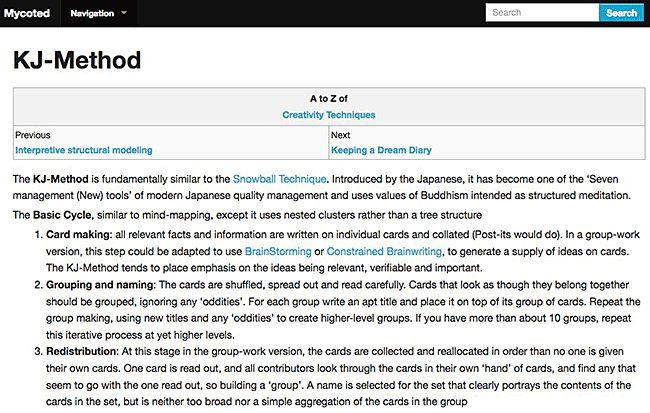K-J Method
Background: The K-J Method was developed as the the Affinity Diagram by Jiro Kawakita in the 1960s and has become one of the Seven Management and Planning Tools used in Total Quality Control.

When repeated in separate cycles focused on different project management activities, the basic K-J brainstorming process becomes a problem-solving process. The method emerged before the internet arrived, so many of the steps, originally accomplished on 3x5 cards and through a suggestion box can now be handled electronically.
Description: The basic cycle described here can performed twice to accomplish two-cycle version consisting of problem definition and idea generation.
A more six-cycle version can accomplish:
- Problem identification
- Circumstances definition
- Diagnosis and problem-formulation
- Solutions and working hypotheses
- Solution activation
- Programmed solution application
Preparation
In advance of the idea-generating session, participants receive a description of the challenge, provided far enough in advance of the meeting in order to give all participants enough time to record ideas and anonymously submit them.
Next, all the submitted, pre-session ideas are copied and distributed among all participants, so that everyone can submit more ideas inspired by the first round of ideas. Again, all ideas remain anonymous. Comments regarding the shortcomings of any idea may be redirected anonymously back to their originators, so that they can upgrade their original idea or submit alternatives.
Session
As a last round of idea gathering, top-of-mind ideas may be submitted anonymously during the first part of the session.
Then a version of the preparation circulation of ideas takes place within the session. Similar to mind-mapping, this basic cycle creates, improves and gathers items in clusters rather than connecting them by lines of relationships.
DiscussionNext Thinking Method »
All of the items are made available on cards and distributed at random among all participants, who announce the ideas in turn as the facilitator transcribes them on flipchart pages. During this phase, anyone can ask for clarification of any idea brought up and recorded. Although all items may be discussed, debate or criticisms of ideas is not allowed.
Items are then prepared for voting. Re-wording, combining, clustering, and consolidation of items continues until the group arrives at a selection of item suitable for putting to a vote.
Voting
Depending on the number of items in play, point values are assigned to the classifications of best, second-best, third-best, etc. Clear winners should emerge. Where there are ties or unclear vaules, discussion follows in order to resolve them, until the the group defines the desired number of prioritized items.
Dispatching
Individuals and groups take ownership of items and take responsibility for implementing each on a deadline.
